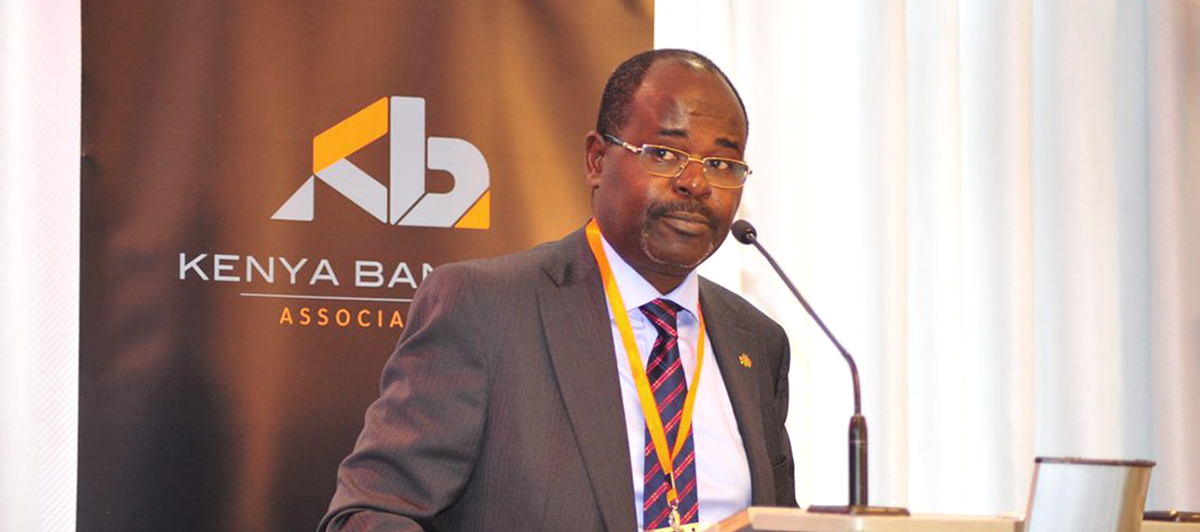
12 Mar Spreading the credit around for a growing Kenya
Dr. Habil Olaka, CEO, Kenya Bankers Association, works to ensure that, despite such challenges as COVID-19, credit — the lifeblood of any growing economy — is freely available to all.
Over the next five years, what will be the biggest trends driving Kenya’s financial access and inclusion moving forward?
From 2006 to 2019 there was quite a significant jump in terms of the progress of financial inclusion. It moved from around 25 percent to 82.9 percent. Regarding the evolution of that space going forward for the next five years, if you look at the 82.9 percent we had in 2019, we have made some good progress but we are not there yet. We still have a good proportion not included. If we look at an analysis of those that are not included, it will give us an indication of what still needs to be done to include them in the financial ecosystem. Interestingly, one of the biggest disadvantaged segments of the community, which do not quite have access to financial services, can be found within the small-and-medium enterprise (SME) space. Yet the SME space is contributing significantly according to the economic indicators, be it through growth, development, or whatever parameter you consider. SMEs play a significant role in our economy.
We also have the youth who, for various reasons, are not quite enabled to participate fully within the financial services space. Another segment that is often forgotten are people living with disabilities. For example, if a person has a hearing disability, the channels that we have for accessing financial services may not consider that person. Most of it is linked with the mobile phone which is specifically suited to somebody who can hear or who can speak. People who are blind, for example, are not able to access those services because the person who designed the channel did not have them in mind. These are various segments, and they make up quite a significant proportion. Developing the channels to ensure that these parts of the population are also included will move the needle. We should be talking about increasing that inclusion to well over 90 percent for us to say that we are really catering to everyone.
The same goes for the youth. We can have specific products that are designed to incorporate the youth into financial services.
What would be the main factors in increasing market penetration and formalizing the banking sector?
One of the things we have learned from our progress in Kenya is the power of liberating technology. Banks in Kenya have really exploited this. If you look at the progress that has been made since 2006, part of the catalyst was the significant push by banks to leverage technology to provide services across digital channels. One way is through mobile banking and its proliferation within the sector. Another way is called agency banking, where you can provide services at various outlets which are not necessarily the normal banking premises. In that way, you can use existing infrastructure — say a petrol station, pharmacy, supermarket, sweet stores, or coffee houses — to provide financial services. These are places that are more familiar and accessible to people.
What would you say are the opportunities for international investors in answering the challenges facing Kenya and its financial services sector?
There is a demand for a substantial expansion of the banking network in Kenya given that a significant segment of the community is not accessing banking services. There is pressure to extend services to those who are excluded. One solution to access them would be through leveraging technology. Hence, this creates immense opportunities for investors to come in either as a fintech or to collaborate with the bank and provide services that can help access the customers in a much more efficient way. There is quite an opportunity in terms of investment in the fintech ecosystem to enable the ecosystem to collaborate with the banking sector. There is also an opportunity, given that banks are expanding to invest directly in themselves. You can bring some fresh thinking to the banks, such as by developing a fintech ecosystem within the banking system itself. That requires innovative new thinking coming from outside into the existing system. That could be another opportunity for investors to look at, given that Kenya has shown an openness and a willingness to proceed in that direction.
In terms of leveraging technology, it is not just facilitating access to the banking sector. Another issue that comes up is that when you are delivering technology, you expose yourself and become more vulnerable to cyberattacks. Now, that is a risk, but it is also an opportunity. It means banks have to significantly invest in cybersecurity to protect themselves. Cybersecurity can either happen by beefing up the systems within the banks or by having service providers who are consistently supporting the banks in terms of enhancing their defenses.
How has the Kenya Bankers Association (KBA) worked to enhance financial inclusion for farmers and agribusiness, and what are your expectations for how supporting the agricultural sector will grow the country’s economy?
That is a very lively debate because of the apparent contradiction. The contradiction comes from the fact that almost 30 percent of the gross domestic product (GDP) is generated from agriculture as a sector, and yet, if you look at the amount of the total portfolio from the banking sector that flows into agriculture, it would be something close to three percent. In a way, you are starving the sector of the necessary resources to be able to grow. Therefore, it has become apparent to the KBA that something needs to be done. We are exploring the causes. Part of it is because our teams within the banking sector do not understand the risks emanating from investment in agriculture. The natural tendency is that if you do not understand something, do not touch it. As a result, you will find an officer is quite comfortable appraising a credit proposal coming from a manufacturing or service sector entity or others but shies away from agriculture. This is in part because most of it is rainfed dependent and we do not have the necessary risk management tools to be able to give comfort to the appraising officer of the fact that the risk can be managed.
Everything about banking is about managing the risk. Thus, one of the areas that we focus on is capacity building in the banking sector to ensure that they have the necessary skills to be able to appraise; and where they are not able to mitigate the risk, they can rely on other service providers who can absorb that risk better. At KBA we have an e-learning platform that is designed to build the capacity of the banking sector. Banking staff enroll on the e-learning platform and there are several modules that give them the necessary skills with the necessary tests to ensure that they have understood the material. It is quite active, and if you look at the number of staff who have gone through the various modules it is quite impressive. In addition to that, we have tried a number of things to provide the necessary mitigating measures for them to be able to address the risks from the research coming from the segment. For example, there is a credit guarantee scheme that was championed by the Kenyan government under the national treasury. Some participating banks were selected in the initial stage. There were about eight of them chosen as participating financial institutions. This is being implemented in phases. Depending on the outcome of phase one, we will have an additional amount. The government put down initial capital in the amount of KES 2 billion. It was increased to KES 5 billion, with a target to reach about $10 billion based on how it is performing. As you can see, several things are being tried to address the various challenges that have been a hindrance to letting the flow of credit into the segment.
The other one, of course, is legislation. In Kenya, we are coming out of an era where there was interest capping. There was a law that had capped the interest rate that the banks could charge a borrower. The problem with that was that banks were not willing to accept risk that was not commensurate with the cap. Anything that went above what the cap prescribes a bank would shy away from. Therefore, there was what we call credit rationing, where banks move away from the higher risk segments and into the lower risk areas. Of course, as we have discussed, agriculture falls directly under the higher risk. Thus, effectively, they were not accessing adequate credit. Fortunately, that law has been repealed. Soon after it was repealed, however, COVID-19 hit us. Now that COVID-19 is starting to subside and the containment measures are beginning to roll out of the way, there are new developments into which credit is beginning to flow. Banks now have the approval in terms of their risk pricing models with the central bank. My hope is that we will see some credit begin to flow to those segments of the economy that have been starved of it for a long time, among them the agriculture sector and SMEs.
Give us an idea of three years into your strategic plan. What is your evaluation of the progress that has been made so far?
We have just done a review of the strategic plan for 2019 to 2023. In 2021, we were just at the midpoint, which was the perfect time to assess the progress we have made and what we still have to do. We assess that we have done quite well based on the milestones that we set for ourselves. Although we were pulled back by COVID-19, we still managed to keep ourselves on track in terms of hitting our milestones. For example, one of the main goals was to have the interest capping law repealed or moderated in a way that would give room to start on lending. We focused on that and in November 2019 that law was repealed, meaning that credit will start flowing to those segments that were denied it during the interest capping period.
But the interesting thing is that the slowdown affected us in the beginning, a little bit before we got our bearings. And once we did, we were then able to work within the constraints to be able to still push our agenda ahead. It became quite normal for us to have meetings with the members and with the various stakeholders online. It became quite easy for us to work as an office, each one of us from our respective bases but still delivering on our mandates.
Would it be fair to say that COVID-19 did then boost digitization in the sector?
Absolutely. We talk about COVID-19 as something that should not have happened. While all that is true, in a way, we learned the hard way that there is a silver lining. The changes that have occurred because of COVID-19 would have taken us another four or five years before they could have been reached. It would have taken a much longer time, for example, for banks to be able to start providing their services wholly on the digital platforms, or even to have bank staff working remotely. However, when COVID-19 came, we did not have a choice. People were locked in their houses, and they could not get back to their offices. We continued to operate. Another example is meetings with the government. Before the pandemic, it was unimaginable to have a Zoom meeting with a government official. It was almost unthinkable because they would tell you that it just does not work like that. It would have taken us another four or five years for us to be where we are today. Today I can book a meeting with a government official. These are just a few of the benefits of this crisis that we have gone through.
Tell us what role you see the banking sector and the KBA in helping the country achieve the ambitions of Vision 2030?
Vision 2030 has three pillars: the economic pillar, the political pillar and the social pillar. It is under the economic pillar that banks play a significant role. The critical is ensuring a flow of credit to the specific segments that are supporting this pillar. Our role is more of a facilitative agent to the various segments that drive this goal. Given the economic structure of Kenya, banking is basically the main supplier of credit, unlike other economies, where the capital markets come in to play a similar kind of a role. We are significantly banking-based in Kenya. It is incumbent upon the banking sector to ensure that there is a fair distribution of credit to the various sectors.
Our role is to ensure we do not starve specific segments like agriculture or SMEs, or the disadvantaged businesses of women, the youth, or people with disabilities. We should not starve them of credit, because then we will not achieve the overall ambitions of Vision 2030. The other thing would be mobilizing savings, which is one of the foundations of the economic pillar. Banks, therefore, significantly mobilize savings from the community. We have seen the promotion of a number of products that are meant to catalyze the mobilization of deposits from the community. Savings play an important role in terms of accumulating capital for the purpose of investment. We have seen banks innovatively coming up with products that will not only help in terms of extending credit but also mobilize savings and use the resources to extend credit to the deserving segments of the economy.


